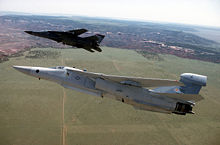AN/ALQ-99

The AN/ALQ-99 is an airborne electronic warfare system, previously found on the EA-6B and now utilised by the EA-18G Growler military aircraft. The ALQ-99E version of the system was carried on the EF-111A Raven aircraft as an escort or standoff jammer.
Description[edit]
The ALQ-99 is an airborne integrated jamming system designed and manufactured by EDO Corporation. Receiver equipment and antennas are mounted in a fin-tip pod while jamming transmitters and exciter equipment are located in under-wing pods. The system is capable of intercepting, automatically processing and jamming received radio frequency signals.[1] The system receivers can also be used to detect, identify and direction find those signals, providing signals intelligence (SIGINT) either automatically or manually.[2]

The AN/ALQ-99 was mounted on the U.S. Navy's and U.S. Marine Corps EA-6B Prowler aircraft and U.S. Navy's EA-18G Growler aircraft. It was mounted on U.S. Air Force's EF-111A Raven aircraft before these aircraft were retired from service by May 1998. The U.S. Navy's EA-6B Prowler were retired from active service following deployment in 2015.
The AN/ALQ-99 has a maximum power output of 10.8 kW in its older versions and of 6.8 kW in its newer versions.[3] It uses a ram air turbine to supply its own power.[4][5]
The AN/ALQ-99 is capable of jamming frequencies from 64 MHz to 20 GHz. Jamming frequency ranges are set forth in 10 bands:
- Band 1: 64 - 150 MHz
- Band 2: 150 - 270 MHz
- Band 3: 270 - 500 MHz
- Band 4: 0.5 - 1 GHz
- Band 5/6: 1 - 1.25 GHz
- Band 7: 2.5 - 4 GHz
- Band 8: 4 - 7.8 GHz
- Band 9: 7.8 - 11 GHz
- Band 10: 11 - 20 GHz [6]
History[edit]

The AN/ALQ-99 has been used during the Vietnam War (1972–1973), Operation El Dorado Canyon (1986 American raid in Libya), 1991 Gulf War, Operation Northern Watch (1992–2003), Operation Southern Watch (1997–2003), 1999 Balkans War, 2003 Second Gulf War, and 2011 Operation Odyssey Dawn. The poor reliability of the ALQ-99 and frequent failures of the Built-In Test (BIT) have caused crew to fly missions with undetected faults. The ALQ-99 also interferes with the aircraft's AESA radar, reduces the top speed of the aircraft and imposes a high workload on the two-person crew when employed in the EA-18G Growler.[7]
Versions[edit]
- AN/ALQ-99A – Entered service in 1972. Covered bands 1, 2, 4, and 7.[6]
- AN/ALQ-99B/C Expanded Capability (XCAP) – Introduced in 1973. Expanded coverage to include bands 5, 6, 8, and 9.[6]
- AN/ALQ-99D Improved Capability (ICAP I) – Introduced in 1975. Expanded coverage to include band 3 and introduced the AYA-6B, an improved computer which allowed faster response times and more automation of the systems
- AN/ALQ-99E – The version mounted on the EF-111A, a heavily modified variant of the F-111A introduced in 1977. The jamming equipment was mostly stored on the underside of the aircraft in the bomb bay, while the receiving equipment was mounted to the vertical stabilizer, similarly to the EA-6B. It featured a 70% commonality with the AN/ALQ-99F ICAP II. Introduced increased computer automation, allowing the jamming systems to be handled by a single crewmate, as opposed to a crew of 3 on the EA-6B. The ALQ-99E underwent several improvements through the late 1980's and early 1990's, including expanded coverage to include band 10, increased computer memory and processing power, and the improved Universal Exciter.[6]
- AN/ALQ-99F Improved Capability (ICAP II) – Introduced in 1980. Featured the AYK-14 computer, with 4 times the memory and increased processing power.[8]
- AN/ALQ-99G ICAP II Block 82 – Introduced in 1982. Allowed limited capability for the EA-6B to carry the AGM-88 HARM missile.[8]
- AN/ALQ-99H ICAP II Block 86 – Introduced in 1988. Improved the EA-6B's ability to carry the AGM-88 HARM missile.[8]
- AN/ALQ-99I ICAP II Block 89 – Introduced in 1996. Introduced the improved Universal Exciter and increased processing power.
- AN/ALQ-99J ICAP II Block 89A – Introduced in 2000. Included the Universal Exciter and expanded coverage to include band 10.
- AN/ALQ-99 ICAP III – Introduced in 2003, initially for the EA-6B. Provided increased processing power and equipment standardization.[6] Carried by the E/A-18G Growler.[9]
See also[edit]
References[6][edit]
- ^ EDO Corporation EA-6B Page Archived 17 October 2006 at the Wayback Machine.
- ^ The Warfighter's encyclopedia Archived 12 August 2006 at the Wayback Machine. EA-6B Prowler Archived 5 November 2004 at the Wayback Machine.
- ^ Cooling Requirements for the Advanced Ram Air Driven Power and Cooling Unit (ARADPCU) on the EA-18G Archived 29 June 2011 at the Wayback Machine.
- ^ "ALQ-99 Tactical Jamming System". U.S.Navy. 16 September 2021. Retrieved 30 July 2021.
- ^ John Pike (11 December 1999). "AN/ALQ-99 Tactical Jamming System (TJS)". Federation of American Scientists (FAS). Retrieved 30 July 2023.
- ^ a b c d e f "EA-6B & EA-18G EW (ALQ-99 & -218 & -227) & NGJ (ALQ-249)" (PDF). Teal Group Corporation. March 2022.
- ^ "GAO-10-388SP, Defense Acquisitions: Assessments of Selected Weapon Programs, March 30, 2010" (PDF). Archived from the original on 21 September 2012. Retrieved 20 March 2011.
- ^ a b c Friedman, Norman (1991). The Naval Institute Guide to World Naval Weapons Systems 1991/92. Naval Institute Press. p. 215. ISBN 9780870212888.
- ^ "U.S. Electronic Attack Aircraft" (PDF). Congressional Research Service. 26 July 2016.
